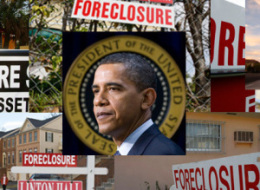Nearly One Year Later, Obama Plan To Help 1.5 Million Struggling Homeowners Yet To Launch
An Obama administration plan announced in April to help up to half of all struggling homeowners avoid foreclosure has yet to officially launch, the Treasury Department acknowledged Friday.
The program, a component of the administration's $75 billion Making Home Affordable effort, was supposed to attack second-lien mortgages, which are additional, second mortgages taken out on a home on top of the initial first mortgage. It's like taking out two loans to pay the same debt.
The Second Lien Program is supposed to automatically reduce the payments on a second mortgage when the first mortgage is modified under the administration's loan modification effort, the Home Affordable Modification Program. The administration says that by lowering monthly mortgage payments, HAMP will eventually help up to four million homeowners stay in their homes
Some housing experts say the second-mortgage component of the plan is necessary to effectively tackle the foreclosure mess -- 3 million foreclosure notices were sent out in 2009; another 3 million are estimated to go out this year -- because so many distressed homeowners have second mortgages. When rolling out the program in April, the administration estimated that "up to 50 percent of at-risk mortgages currently have second liens." Addressing only the first lien is insufficient, experts say, if no changes are made to seconds.
Per the administration's fact sheet on the program accompanying its April 28 announcement:
Second liens contribute to the number of American homeowners unable to afford their housing payments. Even where a first mortgage payment may be affordable, the addition of a second mortgage payment can increase monthly payments beyond affordable levels. In addition, second mortgages often complicate or prevent modification or refinancing of a first mortgage.
The Second Lien Program will help create a sustainably affordable mortgage payment for millions of homeowners who qualify for a first mortgage modification, yet still face challenges in affording their monthly payments because of a second mortgage.
Compounding the problem is the fact that millions of homeowners owe more on their mortgage than their house is worth, putting them "underwater." About a quarter of all homeowners with a mortgage have negative equity, according to real estate research firm First American CoreLogic.
"The single largest problem [with the housing market] is negative equity," said Laurie S. Goodman, senior managing director at Amherst Securities and one of country's top mortgage bond analysts according to Institutional Investor magazine, before a Congressional panel last month. "The [government's] current modification program does not address negative equity, and is therefore destined to fail."

Goodman is right -- the administration's Home Affordable Modification Program [HAMP] does not address negative equity. Rather, it reduces monthly payments for struggling borrowers. Housing experts and consumer advocates agree that lowering monthly payments is a good start to reducing foreclosures. For borrowers with negative equity, though, lower monthly payments does not decrease the total debt owed on the house. In fact, under the administration's plan homeowners end up owing more on their mortgage because mortgage servicers have simply cut interest rates and lengthened the life of the loan, putting them further underwater.
Goodman added: "Any principal reduction program requires the [Obama] administration to address the second lien problem head on...It should be noted that second liens have thus far, under HAMP, been treated with kid gloves."
In an e-mail to the Huffington Post, a Treasury Department spokeswoman confirmed that the eight-month-old program has yet to get off the ground as not a single mortgage servicer has signed a contract with the federal government for this particular effort.
"We don't have any official contracts signed yet, but servicers are committing to the program," Meg Reilly wrote. "We have made enormous progress and continue to move forward with innovative technological development and program implementation and expect to finalize servicer contracts soon."
The hang-up was first discovered by Thomas A. Lawler, a former top official at Fannie Mae and an expert on housing and mortgage matters, who runs Lawler Economic & Housing Consulting.
Part of the reason why it's taken so long for the program to start is due to the complex nature of mortgages, the Treasury Department argues. Mortgages are owned not just by the lenders themselves, but also by investors, who could be anyone from hedge funds to Wall Street banks to municipal pension funds.
"Because there has not been a systematic method of notification to second lien holders when a first lien on the same property is modified, ramp up has taken some time," Reilly said.
Some, like influential New York Times columnist Gretchen Morgenson, have pointed their fingers squarely at four specific culprits -- the four biggest banks in the country.
As of Sept. 30, Bank of America, JPMorgan Chase, Citigroup and Wells Fargo were carrying a combined $452.4 billion worth of second mortgages on their balance sheets, according to the most recent quarterly data filed with the Federal Reserve. That's $92.1 billion in junior-lien mortgages (mostly second liens) and $360.1 billion in home equity lines of credit.
While the Big Four -- which are also the nation's four biggest mortgage servicers -- may be willing to cut borrowers' payments on mortgages owned by investors, doing so for mortgages carried on the Big Four's books would immediately impact their income; after all, less money would be coming in.
But the country's biggest bank may be poised to finally sign onto the program. A Treasury official told the Huffington Post that Bank of America's new CEO, Brian Moynihan, re-committed to Treasury Secretary Timothy Geithner this week the bank's intent to join the administration's second lien effort.
But for now, eight months after the plan's announcement, up to 1.5 million struggling homeowners are waiting for a program that's, thus far, stuck in the mud.







First Posted: 01- 8-10 11:40 PM | Updated: 01- 9-10 02:13 AM